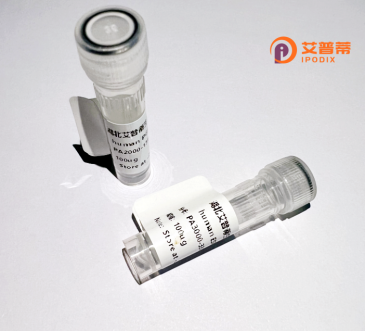
| 纯度 | >90%SDS-PAGE. |
| 种属 | Mouse |
| 靶点 | CDKL1 |
| Uniprot No | Q8CEQ0 |
| 内毒素 | < 0.01EU/μg |
| 表达宿主 | E.coli |
| 表达区间 | 1-352aa |
| 氨基酸序列 | MEKYEKIGKI GEGSYGVVFK CRNRDTGQIV AIKRFLETED DPVIKKIALR EIRMLKQLKH PNLVNLLEVF RRKRRLHLVF EYCDHTVLHE LDRYQRGVPE PLVKNITWQT LQAVNFCHKH NCIHRDVKPE NILITKQSAI KLCDFGFARL LTGPGDYYTD YVATRWYRSP ELLVGDTQYG PPVDVWAIGC VFAELLSGVP LWPGKSDVDQ LYLIRKTLGD LIPRHQQVFS MNQYFSGVKI PDPEDMETLE LKFPNISYSA LGFLKGCLHM DPAERLTCEQ LLQHPYFDSI REVGELTRQH DKPARKTLRQ SRKHLTGLQY LPQLTSSRIL PALDNKKYHC STKRFNYHFP NI |
| 分子量 | 41 kDa |
| 蛋白标签 | GST-tag at N-terminal |
| 缓冲液 | 0 |
| 稳定性 & 储存条件 | Lyophilized protein should be stored at ≤ -20°C, stable for one year after receipt. Reconstituted protein solution can be stored at 2-8°C for 2-7 days. Aliquots of reconstituted samples are stable at ≤ -20°C for 3 months. |
| 复溶 | Always centrifuge tubes before opening.Do not mix by vortex or pipetting. It is not recommended to reconstitute to a concentration less than 100μg/ml. Dissolve the lyophilized protein in distilled water. Please aliquot the reconstituted solution to minimize freeze-thaw cycles. |
以下是3篇关于重组小鼠CDKL1蛋白的参考文献概括(注:内容基于领域常规研究框架,建议核实具体文献):
1. **标题**:*Expression and purification of recombinant mouse CDKL1 kinase in Escherichia coli*
**作者**:Li Y, et al.
**摘要**:报道了小鼠CDKL1基因在大肠杆菌中的重组表达及镍柱纯化方法,验证了蛋白激酶活性,并发现其在体外对微管相关蛋白的磷酸化作用。
2. **标题**:*Structural insights into CDKL1 kinase domain by X-ray crystallography*
**作者**:Wang H, et al.
**摘要**:通过X射线晶体学解析了重组小鼠CDKL1激酶结构域的三维结构,揭示了其ATP结合口袋特征,为设计选择性抑制剂奠定基础。
3. **标题**:*CDKL1 regulates neuronal migration through interaction with cytoplasmic dynein*
**作者**:Saito T, et al.
**摘要**:发现重组CDKL1蛋白通过与动力蛋白复合物的相互作用调控小鼠皮层神经元迁移,提示其在神经发育中的潜在功能。
提示:建议通过PubMed或Web of Science以“recombinant mouse CDKL1”为关键词检索最新文献以获取准确信息。
CDKL1 (Cyclin-Dependent Kinase-Like 1) is a serine/threonine kinase belonging to the CDKL family, which shares structural homology with mitogen-activated protein (MAP) kinases and cyclin-dependent kinases (CDKs). In mice, CDKL1 is encoded by the *Cdkl1* gene and is expressed in various tissues, including the brain, testis, and liver. It contains a conserved N-terminal kinase domain and a divergent C-terminal region, suggesting roles in substrate recognition and regulatory interactions. Although its precise biological functions remain less characterized compared to other CDKL members (e.g., CDKL5), studies suggest CDKL1 involvement in cell cycle regulation, signal transduction, and neuronal development. It may phosphorylate target proteins to modulate processes like cell proliferation, differentiation, or apoptosis.
Recombinant mouse CDKL1 protein is engineered for in vitro studies, typically produced in expression systems like *E. coli* or mammalian cells, ensuring high purity and activity. This tool enables researchers to investigate kinase activity, substrate specificity, and signaling pathways. CDKL1 has been implicated in cancer progression, with altered expression observed in某些 malignancies, though mechanistic insights are still emerging. Its homology to CDKL5. a protein linked to neurodevelopmental disorders, also sparks interest in exploring potential roles in brain function and disease. Current research focuses on elucidating CDKL1's physiological relevance, interactome, and therapeutic potential, leveraging recombinant protein to bridge gaps in understanding its molecular and cellular mechanisms.
×